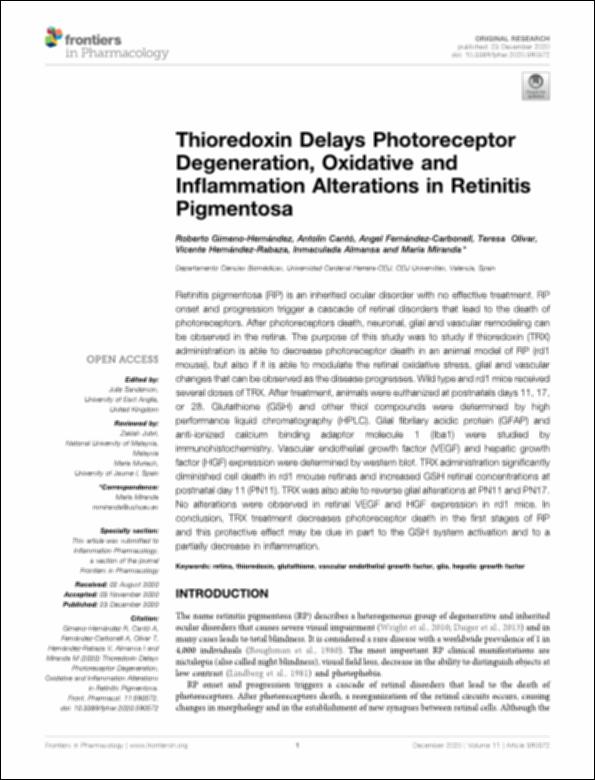Por favor, use este identificador para citar o enlazar este ítem:
http://hdl.handle.net/10637/12677Thioredoxin delays photoreceptor degeneration, oxidative and inflammation alterations in retinitis pigmentosa
| Título : | Thioredoxin delays photoreceptor degeneration, oxidative and inflammation alterations in retinitis pigmentosa |
| Autor : | Gimeno Hernández, Roberto Cantó Catalá, Antolín Fernández Carbonell, Ángel Olivar Rivas, Teresa Hernández Rabaza, Vicente Almansa Frías, María Inmaculada Miranda Sanz, María |
| Materias: | Crecimiento - Factores - Uso terapéutico.; Growth factors - Therapeutic use.; Glutatión - Uso terapéutico.; Retina - Diseases - Treatment.; Retinitis pigmentaria - Tratamiento.; Estrés oxidativo - Tratamiento.; Oxidative stress - Treatment.; Glutathione - Therapeutic use.; Tiorredoxina - Uso terapéutico.; Thioredoxin - Therapeutic use.; Retinitis pigmentosa - Treatment.; Retina - Enfermedades - Tratamiento. |
| Editorial : | Frontiers Media. |
| Citación : | Gimeno-Hernández, R., Cantó, A., Fernández-Carbonell, A., Olivar, T., Hernández-Rabaza, V., Almansa, I. et al. (2020). Thioredoxin delays photoreceptor degeneration, oxidative and inflammation alterations in Retinitis Pigmentosa. Frontiers in Pharmacology, vol. 11, art. 590572 (23 dec.). DOI: https://doi.org/10.3389/fphar.2020.590572 |
| Resumen : | Retinitis pigmentosa (RP) is an inherited ocular disorder with no effective treatment. RP onset and progression trigger a cascade of retinal disorders that lead to the death of photoreceptors. After photoreceptors death, neuronal, glial and vascular remodeling can be observed in the retina. The purpose of this study was to study if thioredoxin (TRX) administration is able to decrease photoreceptor death in an animal model of RP (rd1 mouse), but also if it is able to modulate the retinal oxidative stress, glial and vascular changes that can be observed as the disease progresses. Wild type and rd1 mice received several doses of TRX. After treatment, animals were euthanized at postnatals days 11, 17, or 28. Glutathione (GSH) and other thiol compounds were determined by high performance liquid chromatography (HPLC). Glial fibrilary acidic protein (GFAP) and anti-ionized calcium binding adaptor molecule 1 (Iba1) were studied by immunohistochemistry. Vascular endothelial growth factor (VEGF) and hepatic growth factor (HGF) expression were determined by western blot. TRX administration significantly diminished cell death in rd1 mouse retinas and increased GSH retinal concentrations at postnatal day 11 (PN11). TRX was also able to reverse glial alterations at PN11 and PN17. No alterations were observed in retinal VEGF and HGF expression in rd1 mice. In conclusion, TRX treatment decreases photoreceptor death in the first stages of RP and this protective effect may be due in part to the GSH system activation and to a partially decrease in inflammation. |
| Descripción : | Este artículo se encuentra disponible en la siguiente URL: https://www.frontiersin.org/articles/10.3389/fphar.2020.590572/full |
| URI : | http://hdl.handle.net/10637/12677 |
| Derechos: | http://creativecommons.org/licenses/by/4.0/deed.es |
| ISSN : | 1663-9812 (Electrónico). |
| Fecha de publicación : | 23-dic-2020 |
| Centro : | Universidad Cardenal Herrera-CEU |
| Aparece en las colecciones: | Dpto. Ciencias Biomédicas |
Los ítems de DSpace están protegidos por copyright, con todos los derechos reservados, a menos que se indique lo contrario.


